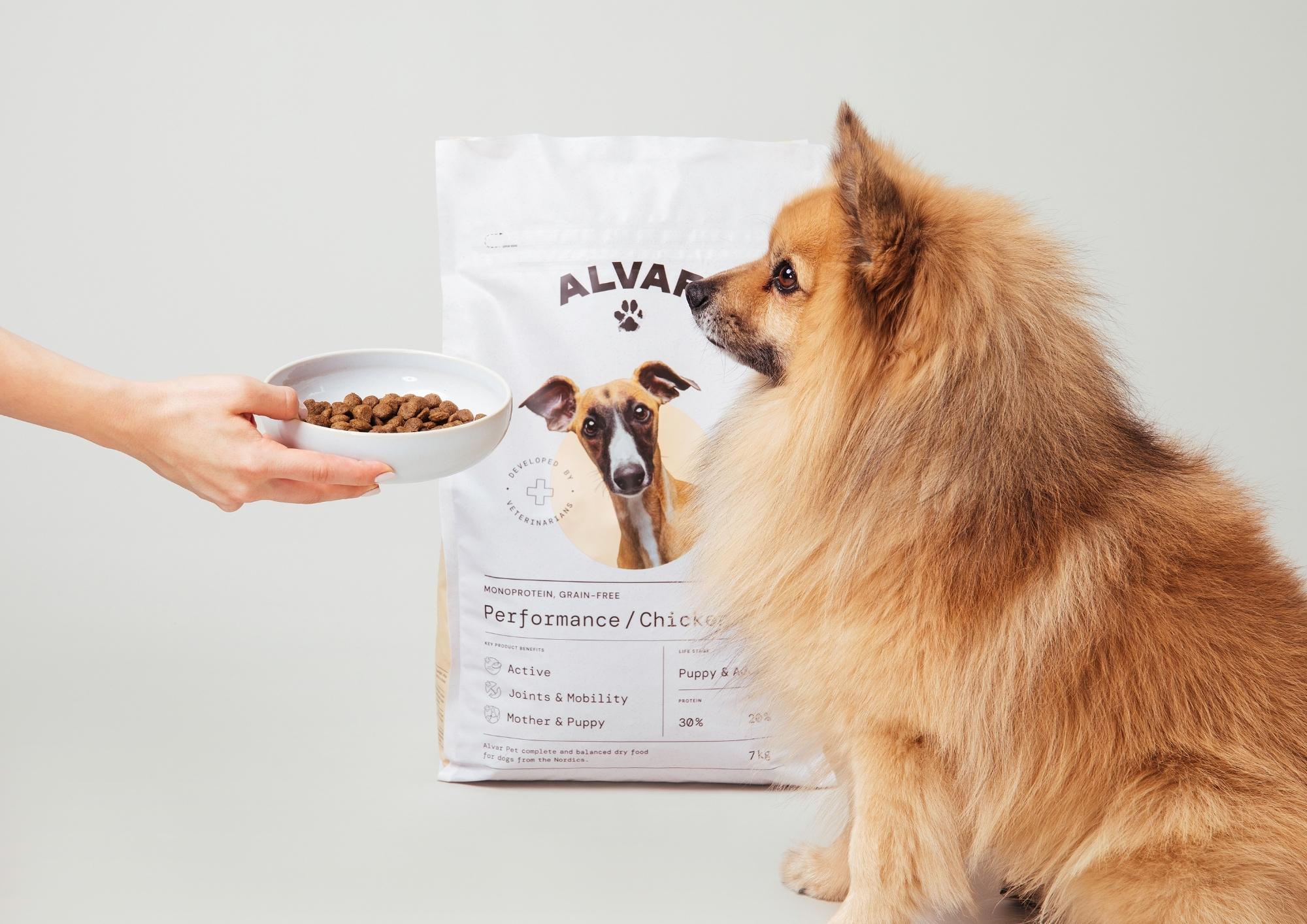In the Alvar Pet portfolio of dry foods, we have a recipe called Root – a plant-based complete and balanced diet for adult dogs. We don't classify it as vegan, as it has synthetically produced vitamin D3.
In this article, we look at the topic of plant-based dog food from a nutritional and scientific point of view, summarising the research in the area. The aim is to aid your understanding and decision-making in finding the most suitable food for your dog.
Plant-based food for dogs – what's the fuss?
Pets are part of society, and owning a dog has been shown to bring people various benefits. Dogs are important companions to humans, helping their owners expand their social networks and improve both physical and mental health [1, 2, 3]. Dogs can also play a significant role in supporting the development of children and young people [4].
Environmental reasons
Nowadays many dog owners also consider the environmental impact of their pets, the so-called carbon paw print, and how it can be reduced. A large part of a pet’s carbon paw print comes from the food bowl, especially through the consumption of animal-based ingredients, such as meat [5, 6, 7].
The simplest and most effective way to reduce a pet’s carbon footprint is to avoid overfeeding, reduce the amount of protein in the diet, and replace meat and animal-based ingredients with alternative protein sources, such as plant proteins [5, 6, 7]. Transitioning to a plant-based diet interests many pet owners, but at the same time, many are concerned whether the food offered is of high quality, balanced, and overall suitable for their dog [8].
Health reasons
As the awareness of allergies and food sensitivities increases, dog owners are often turning to innovative and less common protein sources in order to find a food that suits their allergic or sensitive dog. Where beef and chicken are among the most common allergens for dogs, plant proteins are often well tolerated and can thus provide a solution for tricky dietary issues.
But but, dogs are wolves..
Often, when talking about dog nutrition, there’s a reference to the dog’s relationship with the wolf, followed by the notion that dogs are carnivores and need large amounts of meat in their diet. Taxonomically, according to scientific classification, dogs do belong to the order 'Carnivora', meaning carnivores, and both dogs and wolves belong to the Canis genus.
However, since their domestication, which occurred around 10,000 years ago (and according to some studies potentially as far back as 30,000 years ago) [9], a dog’s metabolism and nutritional needs have changed significantly. One of the biggest changes in dogs’ genes, in addition to behavioral differences from wolves, is their increased ability to process and utilize carbohydrates in their metabolism [10].
Aren't dogs, like cats, carnivores?
Although the anatomy and physiology of a cat’s and dog’s digestive system are similar in many ways, a few important features distinguish them:
- A dog’s molars are better developed than a cat’s for crushing food between the teeth, rather than merely cutting.
- A dog is more efficient than a cat at producing different amino acids in its body and using them more sparingly, so that the amino acids and the nitrogen contained in the proteins can be used for purposes other than energy production.
- A dog’s liver enzymes enable more efficient use of glucose, and its intestinal capacity to break down carbohydrates (starch and glycogen) and absorb glucose is better than a cat’s [11].
Based on these characteristics, cats are considered carnivores while dogs are now classified as omnivores in terms of their nutritional needs.
Building a balanced diet
Dogs need the right amount of energy from their diet, as well as all the essential nutrients such as protein, fatty acids, and minerals 11. Nutritional needs are therefore not defined by the raw materials (such as "meat"), but by the nutrients (such as protein). Nutrients can be obtained from various plant and animal sources. It is possible to create a balanced complete diet for a dog even without meat.
Is there even protein in vegetables, and can dogs utilise them?
Instead of focusing on the total amount of protein, dog food should be designed to meet the dog’s need for essential amino acids, the building blocks of protein [12]. The amino acid composition – the correct balance of essential amino acids – may naturally be more complete in animal-based ingredients, but by combining the right plant protein sources and supplementing with individual amino acids when necessary, it is possible to design a balanced diet for a dog using plant-based ingredients [13, 14].
In the development of pet foods, the main focus is often on ensuring the total protein content, and many current dog foods contain even an unnecessary amount of protein for basic maintenance feeding. This can be one significant factor when assessing the environmental impact of pet foods [5, 6].
The digestibility and utilisation of protein from any ingredient source depend on the quality of the ingredient and the treatments performed on it, such as isolating protein from plant-based ingredients [15, 16]. Ensuring digestibility, and consequently good stool quality, by using high-quality and properly treated ingredients is an important part of the development of dog foods.
Nutritional needs beyond protein
Dogs also need enough energy from their diet, essential fatty acids, and numerous vitamins, minerals, and trace elements. The right amount of digestible starch for energy and fibres and prebiotics to support gut health are also beneficial [17]. The nutrient concentrations naturally vary across different ingredients, and their digestibility and utilisation differ from one source to another.
When designing a complete diet, noe must carefully know the nutrient contents of the ingredients they use, the various treatment-related properties, and their potential interactions, such as their effects on digestibility, in order to create a balanced recipe [18]. It is very difficult, if not impossible, to prepare a balanced plant-based diet for a dog at home.
Protein in a Nutshell
A dog needs protein in its body for a variety of purposes, including muscle and bone development, maintaining many metabolic functions, forming cells and antibodies, and providing an energy source.
The quality of a protein raw material is determined by three key criteria: total protein content (crude protein), amino acid composition, and digestibility.
The protein content of the raw material essentially reflects how much protein that particular ingredient contributes to the food.
The digestibility of the raw material, on the other hand, determines how much of the ingested protein is absorbed from the intestine for utilisation in the body.
Amino acid composition indicates how much and in what ratio the protein raw material contains different amino acids, the building blocks of protein, which are used in the body for the formation of new proteins. A dog requires 10 essential amino acids in its diet, which cannot be produced in the body from other amino acids.
Not sure if my dog will find it tasty?
When comparing dry foods made from different protein sources, no significant difference in palatability has been observed between plant-based foods and those containing animal-based raw materials. A dog’s complete diet consists of several different raw materials, and palatability is the sum of this overall combination and manufacturing process.
Sources
- Barker SB(1), Wolen AR. (2008). The benefits of human-companion animal interaction: a review. J Vet Med Educ. 35(4):487-95.
- Brooks HL, Rushton K, Lovell K, Bee P, Walker L, Grant L, Rogers A. (2018) The power of support from companion animals for people living with mental health problems: a systematic review and narrative synthesis of the evidence. BMC Psychiatry. 2018 Feb 5;18(1):31.
- Friedmann E(1), Son H. (2009) The human-companion animal bond: how humans benefit. Vet Clin North Am Small Anim Pract. Mar;39(2):293-326.
- Purewal R, Christley R, Kordas K, Joinson C, Meints K, Gee N, Westgarth C. (2017) Companion Animals and Child/Adolescent Development: A Systematic Review of the Evidence. Int J Environ Res Public Health. Feb 27;14(3).
- Swanson KS, Carter RA, Yount TP, Aretz J, Buff PR. (2013) Nutritional Sustainability of Pet Foods. American Society for Nutrition. Adv. Nutr. 4: 141–150.
- Okin GS (2017) Environmental impacts of food consumption by dogs and cats. PLoS ONE12(8): e0181301.
- Martens P, Su B, Deblomme S. (2019). The Ecological Paw Print of Companion Dogs and Cats. Bioscience. 69. 467-474. 10.1093/biosci/biz044.
- Dodd SAS, Cave NJ, Adolphe JL, Shoveller AK, Verbrugghe A (2019) Plant-based (vegan) diets for pets: A survey of pet owner attitudes and feeding practices. PLoS ONE 14(1):e0210806.
- Vonholdt BM, Pollinger JP, Lohmueller KE, Han E, Parker HG, Quignon P, Degenhardt JD, Boyko AR, Earl DA, Auton A, Reynolds A, Bryc K, Brisbin A, Knowles JC, Mosher DS, Spady TC, Elkahloun A, Geffen E, Pilot M, Jedrzejewski W, Greco C, Randi E, Bannasch D, Wilton A, Shearman J, Musiani M, Cargill M, Jones PG, Qian Z, Huang W, Ding ZL, Zhang YP, Bustamante CD, Ostrander EA, Novembre J, Wayne RK. (2010) Genome-wide SNP and haplotype analyses reveal a rich history underlying dog domestication. Nature. 2010 Apr 8;464(7290):898-902.
- Axelsson E, Ratnakumar A, Arendt ML, Maqbool K, Webster M, Perloski M, Liberg O, Arnemo J, Hedhammar A, Lindblad-Toh K. (2013). The genomic signature of dog domestication reveals adaptation to a starch-rich diet. Nature. 495 (7441). 10.1038/nature11837.
- National Research Council (NRC). 2006. Nutrient Requirements of Dogs and Cats. Washington, DC: The National Academies Press.
- Fiacco, D.C. & Lowe, J.A. & Wiseman, Julian & White, Gavin. (2017) Evaluation of vegetable protein in canine diets: Assessment of performance and apparent ileal amino acid digestibility using a broiler model. J Anim Physiol Anim Nutr. 102:442-448.
- Brown W, Vanselow B, Redman A, Pluske J. (2009). An experimental meat-free diet maintained haematological characteristics in sprint-racing sled dogs. The British journal of nutrition. 102. 1318-23.
- Knight A, Leitsberger M. Vegetarian versus Meat-Based Diets for Companion Animals. Animals (Basel). 2016;6(9):57.
- Clapper GM, Grieshop CM, Merchen NR, Russett JC, Brent JL Jr, Fahey GC Jr. (2001) Ileal and total tract nutrient digestibilities and fecal characteristics of dogs as affected by soybean protein inclusion in dry, extruded diets. J Anim Sci. 79(6):1523-32.
- Venturini KS, Sarcinelli MF, Baller MA, Putarov TC, Malheiros EB, Carciofi AC. (2018) Processing traits and digestibility of extruded dog foods with soy protein concentrate. J Anim Physiol Anim Nutr. 102:1077–1087.
- Nogueira JPS, He F, Mangian HF, Oba PM, De Godoy. (2019) Dietary supplementation of a fiber-prebiotic and saccharin-eugenol blend in extruded diets fed to dogs. J Anim Sci. 2019 Nov 4;97(11):4519-4531.
- Donadelli RA, Aldrich CG, Jones CK, Beyer RS. (2019) The amino acid composition and protein quality of various egg, poultry meal by-products, and vegetable proteins used in the production of dog and cat diets. Poult Sci. 1;98(3):1371-1378.



